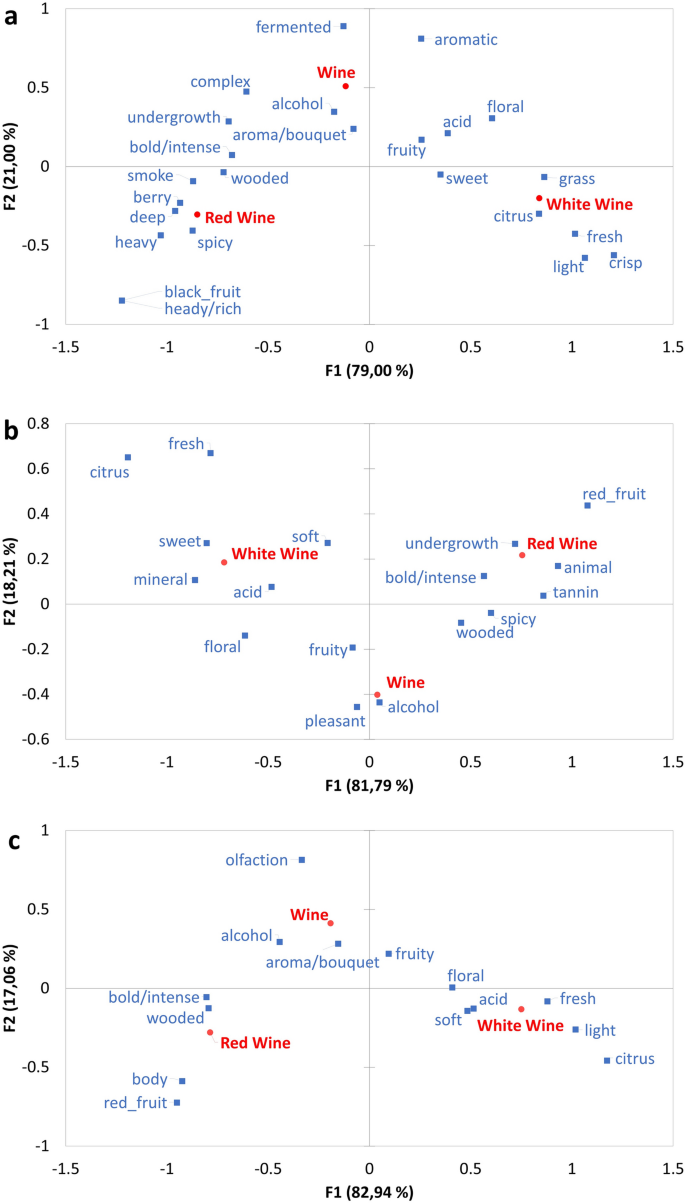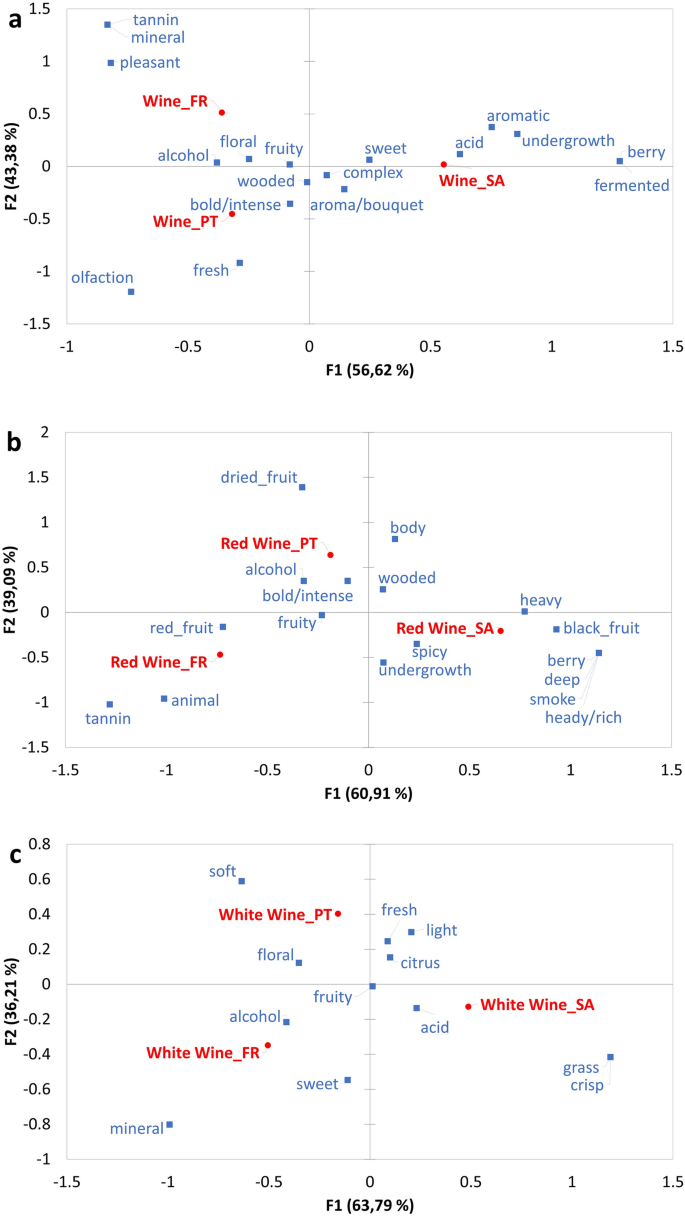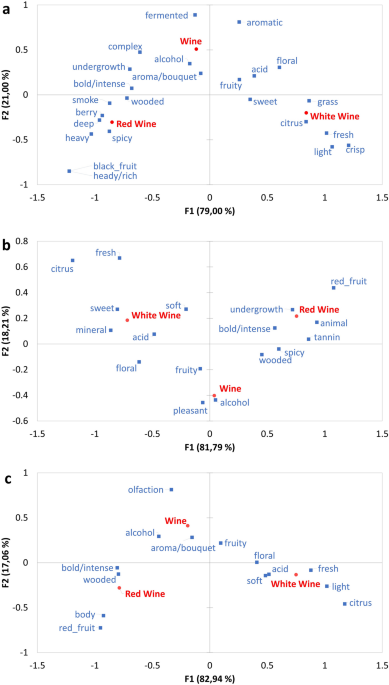Aroma attribute specificity
The aroma attributes were grouped based on their degree of information specificity as generic (fruity), intermediate (tropical or exotic fruit), or specific (pineapple) using an aroma wheel23. Table 4 shows the frequency with which words in these three levels of descriptor specificity were associated with the Wine, White wine and Red wine concepts in the three countries evaluated.
Table 4 The percentage of wine aroma attributes classified as generic, intermediate, or specific based on the aroma wheel used to describe the wine concepts.
In all countries, when the wine concept evaluated is more precise, either White wine or Red wine, consumers generally provided more informative (intermediate and specific) and fewer generic attributes (Table 4). For the French consumers, 86% of the attributes used to describe the global Wine concept were generic, compared to 64% and 71% for the Red wine and White wine, respectively. Interestingly, the data trends suggest that South African consumers were more detailed (specific) in their descriptions than their European counterparts, as shown by the comparatively lower frequencies for the generic descriptors.
At the generic description level, the data show that the foundation of all three wine concepts, regardless of culture, is fruity, spicy and wood whereas other generic descriptors are context specific (Table 4). Minerality was associated with White wine in all three countries, but it was also associated with the global Wine concept by French and the Red wine concept by South African consumers. Some other context differences include French (green, vegetal) and South African (grass, green) consumers highlighting the presence of vegetal and green aromas which are generally absent from the Portuguese data (Table 4). French and South African consumers also cited animal related descriptors, which are entirely absent from the Portuguese dataset.
When comparing the relationship between the different wine concepts, within a culture, the correlation data suggests that the global Wine concept generally correlates with the Red or White wine concepts for the generic attributes (Table 5, Supplementary figure S3). However, the Chi-square test of independence analyses show that the relationship between the Wine and White wine concepts may not be significant in the French cohort (χ2 = 12.39, df = 8, p = 0.13). Additionally, with the increase in the specificity of the descriptor any correlation is generally lost, and cultural differences emerge (Supplementary figure S3).
Table 5 Relationship (Pearson’s correlation and Chi-square tests) between the generic, intermediate, and specific attributes used to describe the wine concepts within cultures.
When comparing the wine concepts across cultures, the generic attributes correlated, however, this correlation was once again not necessarily significant (Table 6), as shown by the Chi-square independence test. Generally, the French and Portuguese generic wine concepts correlated well—Wine: χ2 = 17.46, df = 8, p = 0.03, Red wine: χ2 = 28.36, df = 7, p = 0.00, and White wine: χ2 = 16.44, df = 7, p = 0.02.
Table 6 Relationship (Pearson’s correlation and Chi-square tests) between the generic, intermediate, and specific attributes used to describe the wine concepts across culture.
The aroma-only data shows that the wine conceptualizations of Portuguese, French and South African wine consumers are well aligned at the generic level (Supplementary figure S3), but as the specificity of the attribute increases nuances are more apparent.
Relationships between all descriptors elicited and the wine concept and or culture
Chi-square independence test was used to evaluate whether a relationship exists between two categorical variables, firstly comparing the wine concepts within (Table 7) and then across cultures using all the elicited categorized data. The nature of these relationships was further described using Pearson’s correlation coefficients.
Table 7 Relationship (Pearson’s correlation and Chi-square test) between wine concepts within and across cultures.
Irrespective of cultural background, the Red wine concept differed from the White wine concept (Table 7). Moreover, both the Red wine and White wine concepts demonstrated greater resemblances to the broader global Wine concept. Interestingly, when we compare the concepts across cultures (Table 7), the data show that Wine and White wine mental concepts were generally similar across all cultures. The Red wine concepts showed the poorest similarity with the South African construct more closely resembling the Portuguese (0,57) than the French (0,37). Additionally, the French Red wine construct more closely resembled that of the Portuguese (0,52) than the South African cohort. Indeed, these relative trends are also seen for the Wine and White wine concepts where the South African concepts were more similar to the Portuguese than the French and the French conceptualizations were more similar to the Portuguese.
CA was conducted on the categorized data where a minimum of 10% of the participants used the attribute within (Fig. 1) or across cultures (Fig. 2). For all cultures, the first dimension describes the separation of the Red and White wine concepts (explaining between 79 and 82.9% of the variation in the data), with the general Wine concept, falling between them (Fig. 1). Furthermore, the second dimension describes the separation of this general concept from the two more specific concepts (explaining between 17.1 and 21.0% of the variation). This agrees with the correlation data shown in Table 7.
Figure 1
Evaluating the wine concept differences within each culture. Correspondence analysis comparing the attributes associated with Wine, Red Wine and White concepts by a minimum of 10% of the participants in South Africa (a), France and (b), Portugal (c).
Figure 2
Evaluating the cultural differences for each wine concept. Correspondence analysis comparing the attributes associated with Wine (a), Red (b) and White Wine concepts (c) when used by a minimum of 10% of the participants in at least one of the cohorts in South Africa (SA), France (FR), and Portugal (PT).
In all three countries, fruity was used to describe all wine concepts, although it was more frequently used to describe Wine and White wine than Red wine, when berry related attributes (South Africa—berry, France, and Portugal—red fruit) become more prominent. As expected, attributes often associated with red wine and white wine, were used to describe the Red wine and White wine concepts, respectively.
South Africans associated the generic Wine concept with acidic, alcoholic, wooded, fermented, undergrowth and aromatic attributes. The White wine concept was described as sweet, citrus, grassy, fresh, light, and crisp. The Red wine concept was associated with wooded, spicey, undergrowth, and smoky aromas (Fig. 1a).
The French participants described the Wine concept as pleasant, fruity, and alcoholic. The White wine concept was described as sweet, citrus, fresh, mineral, and soft. The Red wine concept was associated with wooded, spicy, undergrowth, tannin, and red fruit (Fig. 1b).
Lastly, Portuguese respondents used olfaction, alcohol, and aroma/bouquet to describe the general Wine concept. The White wine concept was described as light, citrus, fresh, acidic, and soft. The Red wine concept was associated with wooded and red fruit aromas (Fig. 1c).
When comparing these wine concepts across cultures, the first dimension describes the differences between the French and South African participants for the Red and White wine concepts and European and South African consumers in the case of the general Wine concept (Fig. 2). The second dimension generally highlights the differences between the French and Portuguese participants. Information-poor aroma descriptors such as aromatic (South Africa), aroma/bouquet (South Africa, Portugal), olfaction (Portugal), alcohol (South Africa, France, Portugal), pleasant (France), fermented (South Africa) were associated with the general Wine concept (Fig. 2a). All three cohorts also described the global Wine concept as complex, wooded and fruity.
Fruity, intensity (bold/intense) and wooded attributes were used to describe red wine aroma in all three cultures (Fig. 2b and Supplementary figure S4). Berry attributes were used by the South African cohort, and red fruit in the French and Portuguese. South African and French consumers also used spicy and undergrowth to describe the Red wine concept. South Africans used attributes such as heady/ rich, deep, heavy, smoke, and black fruit to describe the Red Wine concept generally absent from other cultures. Body and dried fruit attributes were associated with the Portuguese Red wine concept.

